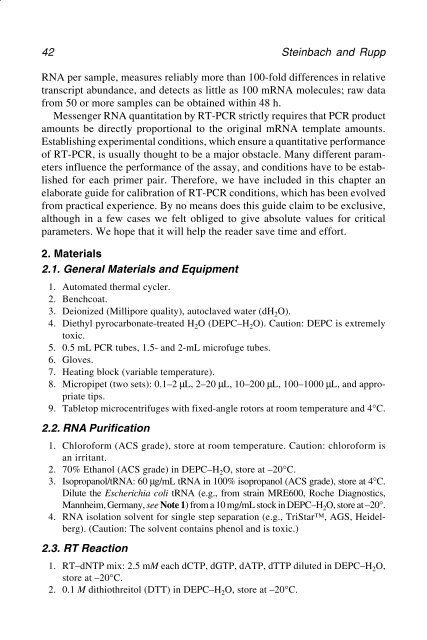Molecular Methods in Developmental Biology Molecular Methods in ...
Molecular Methods in Developmental Biology Molecular Methods in ...
Molecular Methods in Developmental Biology Molecular Methods in ...
- No tags were found...
You also want an ePaper? Increase the reach of your titles
YUMPU automatically turns print PDFs into web optimized ePapers that Google loves.
42 Ste<strong>in</strong>bach and RuppRNA per sample, measures reliably more than 100-fold differences <strong>in</strong> relativetranscript abundance, and detects as little as 100 mRNA molecules; raw datafrom 50 or more samples can be obta<strong>in</strong>ed with<strong>in</strong> 48 h.Messenger RNA quantitation by RT-PCR strictly requires that PCR productamounts be directly proportional to the orig<strong>in</strong>al mRNA template amounts.Establish<strong>in</strong>g experimental conditions, which ensure a quantitative performanceof RT-PCR, is usually thought to be a major obstacle. Many different parameters<strong>in</strong>fluence the performance of the assay, and conditions have to be establishedfor each primer pair. Therefore, we have <strong>in</strong>cluded <strong>in</strong> this chapter anelaborate guide for calibration of RT-PCR conditions, which has been evolvedfrom practical experience. By no means does this guide claim to be exclusive,although <strong>in</strong> a few cases we felt obliged to give absolute values for criticalparameters. We hope that it will help the reader save time and effort.2. Materials2.1. General Materials and Equipment1. Automated thermal cycler.2. Benchcoat.3. Deionized (Millipore quality), autoclaved water (dH 2 O).4. Diethyl pyrocarbonate-treated H 2 O (DEPC–H 2 O). Caution: DEPC is extremelytoxic.5. 0.5 mL PCR tubes, 1.5- and 2-mL microfuge tubes.6. Gloves.7. Heat<strong>in</strong>g block (variable temperature).8. Micropipet (two sets): 0.1–2 µL, 2–20 µL, 10–200 µL, 100–1000 µL, and appropriatetips.9. Tabletop microcentrifuges with fixed-angle rotors at room temperature and 4°C.2.2. RNA Purification1. Chloroform (ACS grade), store at room temperature. Caution: chloroform isan irritant.2. 70% Ethanol (ACS grade) <strong>in</strong> DEPC–H 2 O, store at –20°C.3. Isopropanol/tRNA: 60 µg/mL tRNA <strong>in</strong> 100% isopropanol (ACS grade), store at 4°C.Dilute the Escherichia coli tRNA (e.g., from stra<strong>in</strong> MRE600, Roche Diagnostics,Mannheim, Germany, see Note 1) from a 10 mg/mL stock <strong>in</strong> DEPC–H 2 O, store at –20°.4. RNA isolation solvent for s<strong>in</strong>gle step separation (e.g., TriStar, AGS, Heidelberg).(Caution: The solvent conta<strong>in</strong>s phenol and is toxic.)2.3. RT Reaction1. RT–dNTP mix: 2.5 mM each dCTP, dGTP, dATP, dTTP diluted <strong>in</strong> DEPC–H 2 O,store at –20°C.2. 0.1 M dithiothreitol (DTT) <strong>in</strong> DEPC–H 2 O, store at –20°C.












